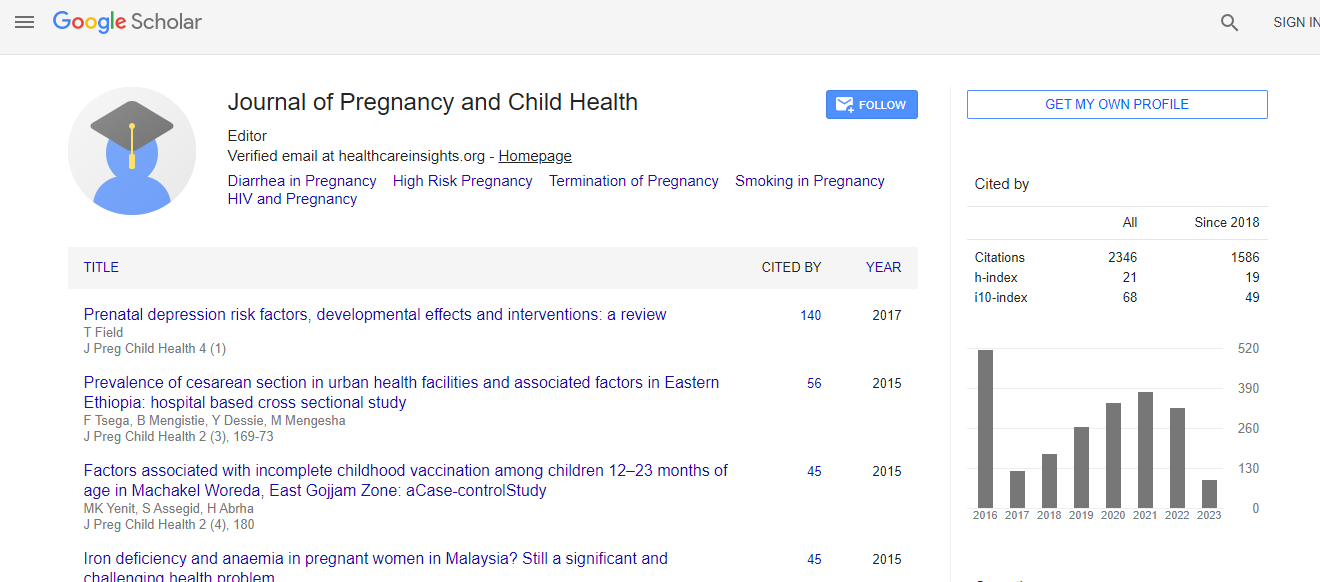Our Group organises 3000+ Global Conferenceseries Events every year across USA, Europe & Asia with support from 1000 more scientific Societies and Publishes 700+ Open Access Journals which contains over 50000 eminent personalities, reputed scientists as editorial board members.
Open Access Journals gaining more Readers and Citations
700 Journals and 15,000,000 Readers Each Journal is getting 25,000+ Readers
Google Scholar citation report
Citations : 3013
Journal of Pregnancy and Child Health received 3013 citations as per Google Scholar report
Journal of Pregnancy and Child Health peer review process verified at publons
Indexed In
- Index Copernicus
- Google Scholar
- Academic Keys
- RefSeek
- Hamdard University
- EBSCO A-Z
- OCLC- WorldCat
- Publons
- Geneva Foundation for Medical Education and Research
- Euro Pub
- ICMJE
Useful Links
Recommended Journals
Related Subjects
Share This Page
Kristina Sundquist
Biography
Kristina Sundquist: Professional Education: Postdoctoral Fellow, Swedish Medical Research Council, Karolinska Institutet (2005-2007) PhD in Family Medicine, Karolinska Institutet (2003) Specialist in Family Medicine (2001) MD, Uppsala University, Sweden (1989) Professional overview Professor of Family Medicine, Lund University (2010-present) Visiting Professor of Medicine, Stanford University (2012-present) Professor of Family Medicine, Karolinska Institutet, Stockholm, Sweden (2007-2010) Principal Investigator for the following projects: FORMAS: 2006-4255. Neighborhood walkability, physical environment, and physical activity (2007-2010). FAS: Neighborhood quality of life and physical activity (2007-2010). VR: 2008-3043. Places, diabetes mellitus type 2, and coronary heart disease (2009-2012). The Swedish Research Council: The genetic and environmental epidemiology of alcohol use disorders (2011-2013). Region SkÃÂ¥ne/LIF: Primary prevention of stroke caused by atrial fibrillation: the FIRST study (2013-2025).Research Interest
Current research interests My research has a strong focus on the influence of individual, family and neighborhood predictors on chronic diseases, with a main focus on cardiovascular disease (CVD) incidence, mortality and risk factors. I have used data from nationwide registers and national and regional surveys and conducted clinical studies to shed new light on potential processes associated with the development of CVD. Results from my research studies can be found in highly ranked journals, such as JAMA, The Lancet, Stroke, Circulation and American Journal of Epidemiology. I was the first researcher to study the concordant (same-subtype) and discordant (different-subtype) associations between ischemic and hemorrhagic stroke. The findings indicated that ischemic and hemorrhagic stroke have different genetic etiologies. In the article ââ¬ÅRisk of pulmonary embolism in patients with autoimmune disorders: a nationwide follow-up study from Swedenââ¬Â (Lancet, 2011), my colleagues and I studied the risk of pulmonary embolism in patients with autoimmune diseases and found that 31 of 33 autoimmune diseases studied were associated with an increased risk of pulmonary embolism. My article ââ¬ÅDifferences in maternal and paternal transmission of coronary heart diseaseââ¬Â (Am J Prev Med, 2006) was chosen by the American Medical Association (AMA) as ââ¬ÅBreaking Newsââ¬Â at a media briefing on cardiovascular disease in New York City. My interest in potential neighborhood influences on CVD risk factors led me to conduct one of the largest studies in the world examining how the built environment might influence physical activity. I used objective measures to characterize all neighborhoods in Stockholm and collected objective data from 2,400 individuals (using accelerometers) to characterize their activity patterns. With the help of experts in Geographic Information Systems, this project produced the first objective measure of neighborhood walkability in Europe. I was one of the initiators of the first experimental laboratory devoted to primary health care research, where my group performs studies to identify clinical biomarkers for CVD-related outcomes, including diabetes and thromboembolic diseases, in different population groups. I have led community-based interventions to improve cardiovascular health in vulnerable suburban populations and I am the project leader of the first study in Sweden aiming to identify patients with inadequate anticoagulant treatment of atrial fibrillation. The project is unique, as it will implement evidence-based medicine to decrease morbidity and mortality in ischemic stroke in a large population of AF patients. Finally, I have extensive ongoing international collaborative projects with Stanford University, Heidelberg University, Virginia Commonwealth University and several universities in Japan, where genetic and environmental influences on chronic disorders such as CVD, cancer and mental disorders are examined.Publications
Neighbourhood Deprivation and Risk of Childhood Visual Impairment: A Nationwide Study from Sweden
Xinjun Li, Jan Sundquist, Bengt Zöller and Kristina Sundquist
Research Article: J Preg Child Health 2015, 2:148
Global Speakers in the subject
Global Experts in the subject
Relevant Topics
Peer Reviewed Journals
Make the best use of Scientific Research and information from our 700 + peer reviewed, Open Access Journals

 Spanish
Spanish  Chinese
Chinese  Russian
Russian  German
German  French
French  Japanese
Japanese  Portuguese
Portuguese  Hindi
Hindi 
